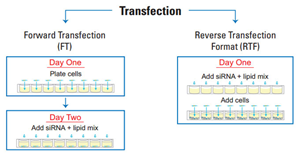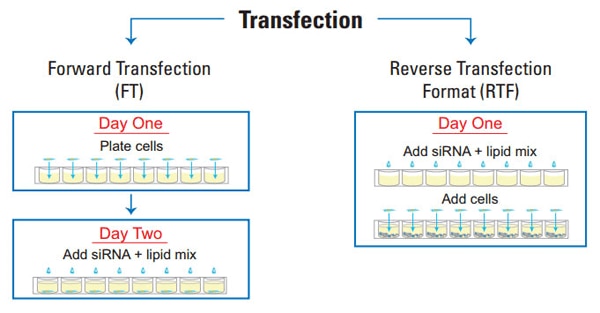Moving nucleic acids into cells
Transfection is the deliberate introduction of nucleic acids into eukaryotic cells. Common transfection examples include introducing DNA plasmids that have gene inserts for expression, or small interfering RNA (siRNA) for targeted gene silencing.
Methods of Delivery
- Cationic lipid- or polymer-based transfection reagents
- Viral-mediated transduction (nucleic acid packaging within a virus vector)
- Electroporation (physical disruption of membrane for entry)
- Proprietary, chemically modified siRNAs
Cationic lipid-or polymer-based reagents are the most common means of transfection and suitable to most cell types. Transfection reagents couple a nucleic acid or an expression plasmid to a cationic lipid or polymer producing a liposome that interacts with the cell membrane and results in endocytosis of the molecule.
Viral-mediated transduction is a good alternative for difficult-to-transfect cell lines, with the added beneficial option of stable cell line creation. DNA within expression vectors can be packaged into viral particles, and then introduced into cells. The virus particle infects the cells and the construct is integrated into the genome, causing the internal host machinery to replicate the exogenous nucleic acids.
Electroporation is a physical means of delivery that is usually the harshest to the cells because it disrupts the cell membrane creating entry for the nucleic acid. This is a good choice for hard-to-transfect cell lines but results in the highest cell death.
In the case of siRNA delivery, a new novel technology exists, in which the siRNA is chemically modified to facilitate uptake into the cell without the need for transfection reagents, instruments, or viral vectors. Modified siRNAs achieve gene silencing in cells that had been beyond the reach of conventional RNAi methods due to toxicity from transfection reagents or undesirable viral responses.

Forward and Reverse Transfection

Schematic comparing forward and reverse transfection.
Forward and Reverse Transfection
Transfection can also occur in vivo. With live animal systems, nucleic acids are delivered systemically or locally to target tissues. In animal models there are additional factors to consider, including the presence of nucleases and the animal's innate inflammatory response, which can interfere with transfection efficiency.
Optimizing transfection protocols ensures maximal nucleic acid uptake by a majority of cells while minimizing cytotoxicity. Maximal transfection efficiency benefits the entire downstream workflow, which can encompass analysis of recombinant clones, gene expression, or gene silencing studies.
How to design a CRISPR gene knockout experiment
See how the ability of Dharmafect Duo to co-transfect DNA and RNA is ideally suited for gene editing applications. This video gives an overview of CRISPR-Cas9 gene editing, and details how the Edit-R™ CRISPR-Cas9 Gene Engineering Platform simplifies the workflow with the use of synthetic RNA.
Order Products
DharmaFECT 1
The most broadly applicable DharmaFECT formulation for optimal siRNA or microRNA transfection into a wide range of cell types for successful RNAi experiments
Dharmafect 2
One of four siRNA/microRNA specific formulations, DharmaFECT 2 is a chemically distinct alternative to one-size-fits-all transfection reagents to achieve high-efficiency silencing in more cell types
Dharmafect 3
One of four siRNA/microRNA specific formulations, DharmaFECT 3 is a chemically distinct alternative to one-size-fits-all transfection reagents to achieve high-efficiency silencing in more cell types
Dharmafect 4
An aliquot of each of the four DharmaFECT formulations for siRNA/microRNA transfection optimization studies
DharmaFECT kb DNA transfection reagent
A unique transfection reagent from our DharmaFECT product line for introduction of DNA into cultured cells with high efficiency and low cytotoxicity
DharmaFECT Duo
Optimized for co-transfection, DharmaFECT Duo transfection reagent provides highly effective delivery of siRNA, microRNA or crRNA reagents with plasmid
Helpful Resources
DharmaFECT Duo Protocol
This protocol is optimized for use with 100 ng/well plnM siRNA in a 96-well plate format
DharmaFECT Duo Co-Transfection of Plasmid and miRIDIAN Reagents Protocol
This protocol is optimized for use with 100 ng/well plasmid and 50 nM miRIDIAN miRNA mimic or 25 nM miRNA inhibitor in a 96-well plate format
Plasmid delivery
- DharmaFECT kb DNA transfection reagent
A unique transfection reagent from our DharmaFECT product line for introduction of DNA into cultured cells with high efficiency and low cytotoxicity
siRNA and microRNA delivery
- DharmaFECT 1
The most broadly applicable DharmaFECT formulation for optimal siRNA or microRNA transfection into a wide range of cell types for successful RNAi experiments - DharmaFECT 2
One of four siRNA/microRNA specific formulations, DharmaFECT 2 is a chemically distinct alternative to one-size-fits-all transfection reagents to achieve high-efficiency silencing in more cell types - DharmaFECT 3
One of four siRNA/microRNA specific formulations, DharmaFECT 3 is a chemically distinct alternative to one-size-fits-all transfection reagents to achieve high-efficiency silencing in more cell types - DharmaFECT 4
An aliquot of each of the four DharmaFECT formulations for siRNA/microRNA transfection optimization studies
Co-transfection of siRNA or microRNA and plasmid
- DharmaFECT Duo
Optimized for co-transfection, DharmaFECT Duo transfection reagent provides highly effective delivery of siRNA, microRNA or crRNA reagents with plasmid
siRNA delivery to difficult to transfect cells
- Accell siRNA
A novel siRNA for difficult-to-transfect cells, modified to require no transfection reagent or viral vector for delivery
Transduction of high-titer viral particles
- Trans-Lentiviral shRNA Packaging System
Package your shRNA viral vector constructs into high-titer lentiviral particles for efficient transduction and gene silencing in the cell or tissue type of interest - Trans-Lentiviral ORF Packaging System
Lentiviral packaging kits with calcium phosphate provide lower cost and higher-efficiency viral packaging
